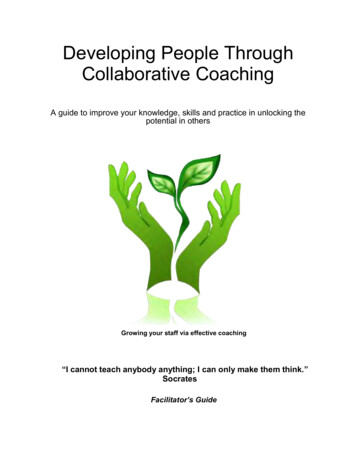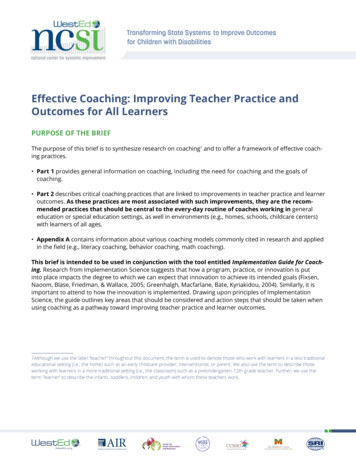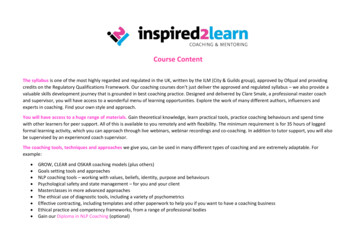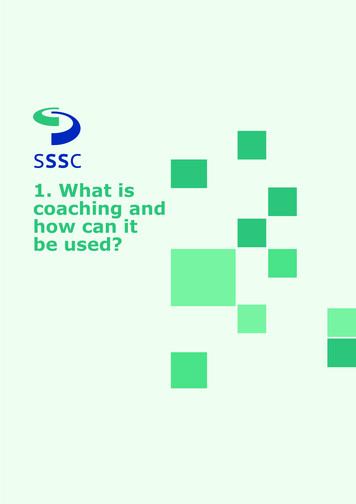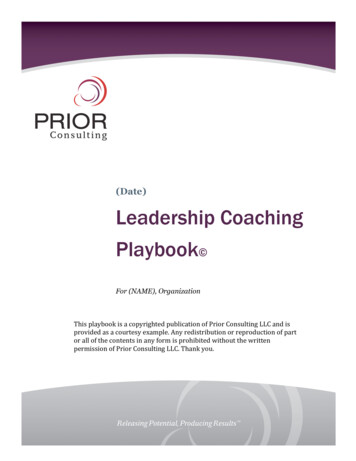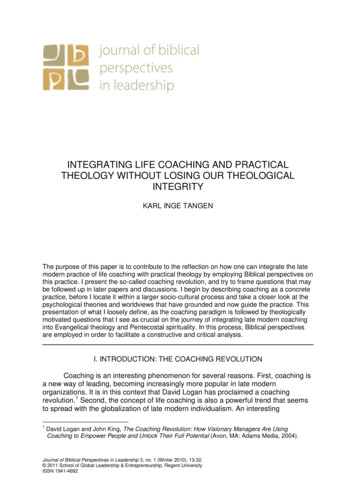
Transcription
INTEGRATING LIFE COACHING AND PRACTICALTHEOLOGY WITHOUT LOSING OUR THEOLOGICALINTEGRITYKARL INGE TANGENThe purpose of this paper is to contribute to the reflection on how one can integrate the latemodern practice of life coaching with practical theology by employing Biblical perspectives onthis practice. I present the so-called coaching revolution, and try to frame questions that maybe followed up in later papers and discussions. I begin by describing coaching as a concretepractice, before I locate it within a larger socio-cultural process and take a closer look at thepsychological theories and worldviews that have grounded and now guide the practice. Thispresentation of what I loosely define, as the coaching paradigm is followed by theologicallymotivated questions that I see as crucial on the journey of integrating late modern coachinginto Evangelical theology and Pentecostal spirituality. In this process, Biblical perspectivesare employed in order to facilitate a constructive and critical analysis.I. INTRODUCTION: THE COACHING REVOLUTIONCoaching is an interesting phenomenon for several reasons. First, coaching isa new way of leading, becoming increasingly more popular in late modernorganizations. It is in this context that David Logan has proclaimed a coachingrevolution.1 Second, the concept of life coaching is also a powerful trend that seemsto spread with the globalization of late modern individualism. An interesting1David Logan and John King, The Coaching Revolution: How Visionary Managers Are UsingCoaching to Empower People and Unlock Their Full Potential (Avon, MA: Adams Media, 2004).Journal of Biblical Perspectives in Leadership 3, no. 1 (Winter 2010), 13-32. 2011 School of Global Leadership & Entrepreneurship, Regent UniversityISSN 1941-4692
Tangen/JOURNAL OF BIBLICAL PERSPECTIVES IN LEADERSHIP14demonstration of this trend is the book, Therapist as Life Coach, written by theclinical psychologists Patrick Williams and Deborah Davis, who recommend thatpsychologists and psychiatrists transform their practice from ―therapeutic counselling‖to ―life coaching.‖2Third, I also suggest that the coaching revolution is influencing practicaltheology in several ways. Christian literature on coaching is growing fast,3 andseveral pastors and theological educators are starting their own businesses as lifecoaches, as a supplement to their more traditional vocations. Courses on coachingare also increasingly introduced to the theological education. Theological educatorsSteve Ogne and Tim Roehl go as far as suggesting that coaching is the mostimportant format of training in the ―missional church of the future.‖4II. HERMENEUTICAL PERSPECTIVE, METHOD, AND PURPOSEThe basic method of this analysis is hermeneutical, in the sense that itemploys an interpretative approach to both science and reality, an approach that alsoembraces dialogue with other interpretative perspectives. My point of departure,which is Pentecostal theology, shares the Evangelical perspective that givesepistemological priority to the Christian story (the Bible) over other life andworldviews. Thus, the Biblical story of history as a theo-drama is understood as boththe first and as the integrative horizon.5 Yet, this analysis nevertheless draws onimportant elements in Don Browning‘s model of critical correlation, and thereforeseeks to facilitate an open dialogue with other perspectives that seek to both listenand learn from other interpreters.6III. THE MEANING AND ETYMOLOGY OF ―COACHING‖The word coach has, as Gary Collins notes, interesting etymological roots.7From the 1500s and onward, the word described a horse-drawn vehicle. Fromaround 1880, the word was given an athletic meaning, identifying the person whotutored rowers at Cambridge University to ―move from one place to another.‖8 Soeven if late modern-life coaching may have its major roots in modern individualistpsychology, the image of a ―sports coach‖ who comes alongside someone (or ateam) to help people move from one place to another, may possibly be used as―deep metaphor,‖ or root-metaphor of this practice. Simply defined then, coaching is2Patrick Williams and Deborah C. Davis, Therapist as Life Coach: An Introduction for Counselors andOther Helping Professionals, rev. ed. (New York: W.W. Norton, 2007).3Gary R. Collins, Christian Coaching: Helping Others Turn Potential into Reality (Nashville: Navpress,2001); Steve Ogne and Tim Roehl, Transformissional Coaching: Empowering Leaders in a ChangingMinistry World (Nashville: B & H, 2008); Joseph Umidi, Transformational Coaching (Longwood, FL:Xulon Press, 2005).4Ogne and Roehl, Transformissional Coaching, 10-21.5Kevin J. Vanhoozer, The Drama of Doctrine: A Canonical Linguistic Approach to Christian Doctrine(Louisville, KY: Westminster John Knox Press, 2005).6Browning‘s model is embraced with some caution. For a critical review of the model see RaySherman Anderson, The Shape of Practical Theology: Empowering Ministry with Theological Praxis(Downers Grove, IL: IVP Academic, 2001); Don S. Browning, A Fundamental Practical Theology(Minneapolis, MN: Fortress Press, 1991).7Collins, Christian Coaching, 14-15.8Ibid., 45.Journal of Biblical Perspectives in Leadership 3, no. 1 (Winter 2010), 13-32. 2011 School of Global Leadership & Entrepreneurship, Regent UniversityISSN 1941-4692
Tangen/JOURNAL OF BIBLICAL PERSPECTIVES IN LEADERSHIP15a practice in which one person comes alongside another in order to help him or herachieve certain goals.At this point it may be useful, however, to clarify the distinction between lifecoaching and performance coaching. Performance coaching is, according to SteveOgne and Tim Roehl, orientated towards effectiveness in a distinct area, such as jobperformance (in a Christian context, ministry).9 It focuses on the larger context orpersonal life of the leader only if this has negative impact on performance. Incontrast, holistic life coaching approaches the whole person and seems to value―personal authenticity and character as well as the person‘s relationships to othersand community.‖10 Williams and Davis‘ secular approach is just as holistic.11 Theirmodel of the life balance wheel includes several dimensions in this form ofconversation, including: life purpose, family and friends, finances, romance/intimacy,health/self-care, social fun, personal and spiritual development, and one‘s physicalenvironment. I find Williams and Davis‘ model to be of particular interest because it ismore philosophically conscious than many other models.IV. LIFE COACHING: KEY PRACTICES AND VIRTUESFor this reason, it might be useful to look at what Williams and Davis define asthe basic practices of coaching, and the associated virtues. In their model ofcoaching, the coach is primarily given the role of a partner in a conversation on theclient‘s or PBC‘s (Person Being Coached) life. But what does this partner do?According to Williams and Davis, a coach on a basic level mainly practices ―listening‖and ―truth-telling‖ in four (well-prepared) steps:1. Listens and clarifies2. Reflects what he or she is hearing3. Listens more4. And requests action12The coach should, according to Williams and Davis, primarily listen for whatthe PBC wants to accomplish and wants to be. The coach should look for and identifypeople‘s goals and strengths―and compliment and endorse these―while at thesame time also listen for the gap between where the person is and where he or shewants to be. In this process, the coach is ―solution focused‖ rather than therapeutic,in the sense that he or she looks for possibilities rather than for pathology, history,pain, and psychological blocks.13What does it mean to tell the truth? Telling the truth is about pointing outpotential incongruence or intuitions about problem areas, and pointing out the client‘sstrengths. It might be useful to note here what telling the truth is not. It does notmean to confront and, more importantly, the good coach listens for and with the clientfor the client‘s agenda, not what the coach thinks the agenda and direction should9Ogne and Roehl, Transformissional Coaching.―This transformational paradigm helps leaders live authentically and ‗incarnationally‘. . . . A goodcoach is focused on the holistic development of the leader. A coach must focus on the four areas,helping the leader clarifying calling, cultivate character, create community, and connect with culture.‖Ogne and Roehl, Transformissional Coaching, 29.11Williams and Davis, Therapist as Life Coach, 31.12Ibid., 99-103.13Ibid., 101.10Journal of Biblical Perspectives in Leadership 3, no. 1 (Winter 2010), 13-32. 2011 School of Global Leadership & Entrepreneurship, Regent UniversityISSN 1941-4692
Tangen/JOURNAL OF BIBLICAL PERSPECTIVES IN LEADERSHIP16be.14 For many coaches, this is an important absolute, to the degree that they rejectother forms of counseling and guiding conversations. In his extensive work onChristian coaching, Gary Collins gives the following review of the coaching literature:―A perusal of the many available books on coaching shows that most authorsemphasise the ability of the PBCs to ‗look inside‘ with the help of their coaches, tolisten for the values, the purposes and visions that are deep within, to focus on innerstrengths, and to discover their passions and life purposes. There are no absolutesand few rules in this thinking.‖15 However, it‘s worth noticing that ―listening for thesolution‖ is a great obstacle to great coaching, according to Williams and Davis,because it blocks the powerful process of discovery, ―uncovering,‖ and creative ideasthat come from the coaching conversation.16 The latter point is important because itmeans that the person being coached is, at least ideally, not only his or her ownvisionary lawgiver (autonomos), he or she is, at least in a narrow sense (notnecessarily ultimately), also his or her own self-creator (autopoesis).Coaching then, is a practice of empowerment providing or aiming at providinga particular kind of freedom, in terms of individual self-creation or, if one likes, selfactualization. Freedom here means the ability to set one‘s own holistic life goals andthe ability to achieve those goals ―from within.‖ That this approach and perspective isan important value in this paradigm is affirmed by some of the advanced skills andpractices that Williams and Davis promote, such as: Purposeful inquiry, which basically means to move together, guided bycuriosity Never make the client wrong, which means that the coach should focus onwhat the client needs, and not on what the coach thinks he or she needs ―Possibility thinking,‖ which means to see and encourage courageous andpositive thinking ―Standing for,‖ which means ―remembering the dreams of their clients. Andbelieving in the possibility of realizing them‖ Reframing, which means to help the PBC to see situations in new anddifferent perspectives. The use of metaphors and parables to stimulate the PBC‘s imagination17V. LIFE COACHING IN A SOCIOLOGICAL PERSPECTIVEForms of Individualism and Social Systems: The Modern ProjectSome of these skills are presented in more depth later. At this point, however,it might be useful to see coaching within a larger sociological perspective. I suggestthat Robert Bellah‘s analysis of late modernity in general and American culture inparticular, may be useful in this regard, since the coaching revolution has emerged inan American context. The great project of modernity, according to Bellah, is freedom,understood as independence from social and religious coercion.18 Like Charles14Ibid., 101-102.Collins, Christian Coaching, 20.16Williams and Davis, Therapist as Life Coach, 101.17Ibid., 107.18Robert N. Bellah and Steven M. Tipton, eds., The Robert Bellah Reader (Durham, NC: DukeUniversity Press, 2006); Robert N. Bellah, Richard Madsen, William M. Sullivan, Ann Swidler, and15Journal of Biblical Perspectives in Leadership 3, no. 1 (Winter 2010), 13-32. 2011 School of Global Leadership & Entrepreneurship, Regent UniversityISSN 1941-4692
Tangen/JOURNAL OF BIBLICAL PERSPECTIVES IN LEADERSHIP17Taylor, he identifies a massive ―subjective turn‖ in the history of modern culture, interms of a turn from external authorities to the self as a source of significance.19The modern project is, however, also shaped and driven by social systems.Following Jürgen Habermas, Bellah makes an important distinction between ―lifeworlds‖ and ―systems.‖20 Somewhat simplified one might say that the life world is therealm of mutual understanding and meaningful relationships, while systems on theother hand are organized through nonlinguistic media, exemplified by modern marketcapitalism and the administrative nation–state.Modernization, according to Habermas, involves two complementaryprocesses: the rationalization of the life world through modern forms of rationalities,and the differentiation of the systems from the life world.21 The problem withdifferentiation is that the systems become autonomous to the degree that they are nolonger anchored in the moral universe of the life world, instead they seek tosubordinate the life world to forms of ―functionalist reason,‖ meaning that concernsfor efficiency and profit invade the moral realm.Different Languages and Types of Late-Modern IndividualismsThus, certain cultural forms or interpretative repertoires may feed on thesesystems, and in particular what Bellah calls utilitarian individualism. In a classicstudy, Bellah and his colleagues originally identified four kinds of late-modern―individualisms‖22―all sharing the basic belief in the dignity and ―sacredness‖ of theindividual.23 However, only two of these qualify as forms of individualism, and in amore narrow sense as ―first languages.‖ These interpretative repertoires see theindividual as the primary reality, whereas society is a conceived second-orderconstruct.Utilitarian IndividualismUtilitarian individualism has its philosophical roots in the seventeenth andeighteenth centuries.24 It has affinity to a basically economic understanding of humanexistence, and views human life as an effort by individuals to maximize their selfinterest relative to their given ends. Thus, it is highly compatible with marketcapitalism. ―The utilitarian self,‖ according Steve Tipton, asks: ―What do I want? Or,what are my interests?‖25 His answer to this first question then defines ―goodness ofconsequence.‖ Ethics is primarily understood in terms of procedures of fair exchange(between self-maximizing individuals), and freedom is understood as freedom toSteven M. Tipton, Habits of the Heart: Individualism and Commitment in American Life (Berkeley,CA: University of California Press, 2008).19Ibid.20Bellah et al., The Robert Bellah Reader, 107-109.21Jürgen Habermas, In Theory of Communicative Action and System (Cambridge, MA: Beacon Press,1987).22Bellah et al., Habits of the Heart.23See the authors‘ own assessment of these terms in Bellah et al., Habits of the Heart, 334.24See Bellah et al., Habits of the Heart, ch. 2. Here Bellah explicitly mentions Thomas Hobbes andJohn Locke as philosophical fathers of this tradition.25Linda Woodhead and Paul Heelas, Religion in Modern Times: An Interpretive Anthology (Oxford,UK: Wiley-Blackwell, 2000), 369.Journal of Biblical Perspectives in Leadership 3, no. 1 (Winter 2010), 13-32. 2011 School of Global Leadership & Entrepreneurship, Regent UniversityISSN 1941-4692
Tangen/JOURNAL OF BIBLICAL PERSPECTIVES IN LEADERSHIP18pursue one‘s interests.26 The realizations of these interests are often referred to assuccess. Bellah and his colleagues propose that there are several key images to theutilitarian mode of thinking, such as the independent citizen, the self-madeentrepreneur, and the successful manager (or organizational leader).27Expressive IndividualismWhat Bellah calls expressive individualism has its roots in the Romanticism ofthe nineteenth century, and arouse in opposition to the utilitarian life mode. Itrepresents a search for a deep understanding of what it means to be ―an authenticself,‖ or ―a whole person.‖28 In its classical ―romantic form,‖ it holds that each personhas a unique core of feelings and intuitions that should unfold or be expressed.29 AsHeelas and Woodhead suggest, expressive individualists go deeper in their cateringof themselves, and the search for subjective well-being includes a quest forauthenticity, creativity, personal growth, meaningful relationships, and the experienceof harmony or holism.30 In Bellah‘s material, this also leads people into differenttherapeutic practices, in which the individual tries to deal with both externalauthorities and internal anxieties that obstruct the individual‘s freedom to develop andexpress one‘s ―true self.‖ The holistic self-accepting and self-actualizing individual, aswell as the therapist, may therefore be seen as typical characters of the narratives ofexpressive individualism.This ethics has been described (critically) by Charles Taylor as ―an ethics ofauthenticity,‖31 and may have two components. First, it thinks of an action as morallyright if one acts, in any given situation, in a way that fully expresses oneself,specifically one‘s inner feelings and one‘s experience of the situation. 32 Second, itmay include what Bellah and Tipton call therapeutic contractualism: ―Thus sharing offeelings with somebody that in turn responds similarly. Thus sharing of feelingsbetween similar, authentic, expressive selves―selves who to feel complete do notneed others and do not rely on others to define their own standards ordesires―become the basis for the therapeutic ideal of love.‖33 In its ideal typicalform, the therapeutic attitude denies all forms of external obligations in relationships,replacing them with the ideal of open and honest communication and ―fairpsychological exchange.‖3426Bellah et al., The Robert Bellah Reader, 268.The role of the professional manger is important because the modern bureaucratic organization maybe perceived primarily as a utilitarian corporation. See Bellah et al., Habits of the Heart, 39-46.28The idea of the inner voice could also be combined with orthodox theism, but in many cases thisbelief develops towards pantheism or secularism. See Charles Taylor, Sources of the Self: TheMaking of Modern Identity (Cambridge, UK: Cambridge University Press, 1989), ch. 21.29Bellah et al., Habits of the Heart, 334.30See Heelas and Woodhead, Religion in Modern Times , 370; see also Paul Heelas, LindaWoodhead, Benjamin Seel, Bronislaw Szerszynski, and Karin Tusting, The Spiritual Revolution:Why Religion is Giving Way to Spirituality (Malden, MA: Wiley-Blackwell, 2005).31Charles Taylor, The Ethics of Authenticity (Cambridge, MA: Harvard University Press, 1992).32See Tiption‘s anlaysis in Woodhead and Heelas, Religion in Modern Times, 370.33Bellah et al., Habits of the Heart, 121-130.34Giddens calls this ―the pure relationship.‖ See Anthony Giddens, The Transformation of Intimacy:Sexuality, Love, and Eroticism in Modern Societies (Oxford, UK: Polity Press, 1992).27Journal of Biblical Perspectives in Leadership 3, no. 1 (Winter 2010), 13-32. 2011 School of Global Leadership & Entrepreneurship, Regent UniversityISSN 1941-4692
Tangen/JOURNAL OF BIBLICAL PERSPECTIVES IN LEADERSHIP19Individualism as Loose-Transactional ConnectionsI suggest that in a sociological perspective, moderate individualism does notprimarily mean forms of social independence, or forms of eremitism. Individualism is,in a sociological perspective, primarily a way of relating to others. The utilitarianindividualist obviously needs others to succeed.35 Therapeutic contractualism maycome closer to an arena where altruistic proximity and authentic care is performed,but ―the other‖ is primarily in this paradigm a partner who acts both as client andcoach, in a transactional process.Win–win solutions in the paradigm of individualist languages are thereforebasically transactional deals between two sets of individual interests, rather than thetransformational idea of the common good that benefits all, including those notpresent in the transaction. ―The other‖ is therefore always in danger of being used, orbeing reduced to an audience for utilitarian (success) or expressive self-actualisation.The American sociologist Robert Wuthnov suggests that this development meansthat forms of solid communities (including churches) are transformed into forms of―loose connections.‖36The practical theologian and leadership theorist Robert Banks offers atheological perspective on this process. He claims that covenantal relationships,understood as ―binding two parties unconditionally for a particular purpose or lengthof time,‖ are steadily replaced by ―contractual relationships of limited duration, withbuilt in conditions.‖ He argues that ―this trend‖ is noticeable ―even‖ in marriage,friendships, and church.37From a more European perspective, Ulrich Beck and Elisabeth BeckGernsheim suggest that collective identities, such as the identity of class, seem towither away in the post industrial economy, and that the national welfare state alsoseems to fuel the process of individualization, since it is designed to supportindividuals, rather than groups.38 Zygmunt Bauman proposes that we now live in a―liquid modernity,‖ shaped by the post industrial transition from ―production toconsumption,‖ which is shaping both professional relationships and intimatepartnerships in the image of ―until further notice rationality,‖ based on mutual use andconsumption. This logic transforms interpersonal intimacy to ―episodic‖ or ―liquid‖love.39Strategies of individual self-actualization are therefore not only a choice in thelate-modern context, but Beck and Beck Gernsheim suggest that late-modern peopleare condemned to individualization,40 in the sense that they must stage and manage35Even Ridderstråle and Nordström, who celebrate the funky ethos of late-modern individualism,admit that one needs the competence of others to be ―on the edge.‖ Jonas Ridderstråle and KjellNordström, Funkey Business: Talent Makes Capital Dance (Upper Saddle River, NJ: PearsonEducation, 2000), 210-212.36Robert Wuthnow, Loose Connections (Cambridge, MA: Harvard University Press, 2002).37Robert J. Banks, Paul’s Idea of Community: The Early House Churches in Their Cultural Setting,rev. ed. (Peabody, MA: Hendrickson, 1994), 15.38Ulrich Beck and Elisabeth Beck-Gernsheim, Individualization: Institutionalized Individualism and ItsSocial and Political Consequences (Thousand Oaks, CA: Sage, 2002).39Zygmunt Bauman, Liquid Love: On the Frailty of Human Bonds (Cambridge, UK: Polity Press,2003), 89-91.40Beck and Beck-Gernsheim, Individualization, 4.Journal of Biblical Perspectives in Leadership 3, no. 1 (Winter 2010), 13-32. 2011 School of Global Leadership & Entrepreneurship, Regent UniversityISSN 1941-4692
Tangen/JOURNAL OF BIBLICAL PERSPECTIVES IN LEADERSHIP20their own biography, and adapt adequately to the dialectics of local and globalsystems.41 At this point, I suggest that the metaphor of being condemned might implya too strong form of sociologism (viewing individual thoughts too much as anepiphenomena of the socio-cultural contexts). Yet, even if Beck and Beck Gernsheimare only partially correct, both their and Bellah‘s perspectives might explain why lifecoaching is becoming so popular. It obviously addresses urgent individual needs,and the emphasis on individual self-creation provides hope corresponding to thedominant interpretative repertoires.VI. THE PSYCHOLOGICAL ROOTS OF LIFE COACHINGFrom a theological perspective, one must ask what kind of worldviews andethics are embedded in the practice of coaching. Davis and Williams suggest thatSigmund Freud had a dramatic influence on society‘s view on both mental illness andhuman behavior in general. They state, however, that Freud‘s theories have littleapplicability to life coaching, instead Freud and his students lay the foundation for theparadigm they call traditional therapy or old style counseling. They see the followingcharacteristics as typical of this psychoanalytic paradigm.42 Deal primarily with pathology Orientated towards the inner world of process and feelings Approach this world with ―why questions‖ towards the client‘s past/biography Basically a medical model where the therapist is expert (doctor) and theclient is a patientModels of life coaching may find their theoretical antecedents among Freud‘sstudents. Williams and Davis put forward that both Carl Jung and Alfred Adler ―brokeaway from Freud‘s theories of neuroses and psychosis,‖ and propose that they―posited theories that were more teleological and optimistic about human potential.‖43Adler saw each individual as the creator and artist of his or her own life, and involvedhis clients in goal setting, life planning, and inventing their own future. Happiness waseventually found in a sense of social connectedness and significance. The sameapplies to Jung‘s journey towards a higher self (individuation), which was also an actof self-creation, through visionary and purposeful living that culminated in selftranscendence.44Williams and Davis also see Carl Rogers book, Client-Centred Therapy,45 as amajor contribution to later models of coaching. Together with other theorists, likeAbraham Maslow, Rogers formed the ―third force‖ of humanistic psychology, focusingmore on personal development towards self-actualization and well-being, rather thanon pathology. His contribution is of particular importance because it definedcounseling and therapy as a relationship in which the client was assumed to have theability to change and grow. The principle of unconditional positive regard sawaffirming the client as the key to change, and this redefined the former imbalanced41See Anthony Giddens, Modernity and Self-Identity: Self and Society in the Late Modern Age(Cambridge, UK: Polity Press, 1991), 214-215, 243.42Williams and Davis, Therapist as Life Coach, 11, 40-46.43Ibid., 11-12.44Ibid.45Carl R. Rogers, Client-Centered Therapy (Cambridge, MA: Houghton Mifflin, 1951).Journal of Biblical Perspectives in Leadership 3, no. 1 (Winter 2010), 13-32. 2011 School of Global Leadership & Entrepreneurship, Regent UniversityISSN 1941-4692
Tangen/JOURNAL OF BIBLICAL PERSPECTIVES IN LEADERSHIP21relationship between the therapist and the client into a more equalitarian ―therapeuticalliance.‖46The main psychological basis for coaching is, however, found in what Williamsand Davis call ―solution focused approaches,‖ associated with the father of Americanhypnosis, Milton Erickson, and his students Bandler and Grinder, who formed theparadigm of neuro-linguistic programming (NLP) in their landmark study, TheStructure of Magic.47 Solution-focused approaches do not depend on insight or depthpsychology; they focus less on pathology and the past, and more on behavioralchange through increased awareness, and choices that allow for a desired future(cognitive psychology). Language and questions that focus the client ―towards whatworks, rather than towards what is broken,‖ are seen as powerful andtransformational tools for a process of personal development. Typical characteristicsof these transitional models are therefore: The client is ―supported‖ rather than cured in a therapeutic alliance A ―move away from the focus on pathology‖ to a ―paradigm of solution‖ A more ―brief‖ solution-focused approach, orientated towards ―outcome‖ Language is seen as a primary tool for desired change (also for the innerconversation)48Williams and Davis suggest that models of life coaching have evolved from a varietyof solution-based approaches that include NLP, systemic family therapy (Haley,Madnes, Satir), Ellis‘ rational emotive therapy, and Glasser‘s reality therapy. Theirown model may probably also be seen as a relatively eclectic psychological hybridthat also incorporates impulses from performance coaching in organizationaldevelopment, and models of personal development, such as that of AnthonyRobbins,49 which is focusing on possibility thinking and visionary living. Coaching,according to their model is characterized by: Paradigm of possibility and human potential A move from ―Why?‖ to ―How?‖ Action from the inner to the outer world (inside-out) through transformativelanguage and practices orientated towards an outcome Outcome is defined by a larger vision of the future Focus on a holistic life Coach is seen as a co-creator in ―a partnership of equals‖ Thus, providing freedom from ―managed care‖50Overall then, Williams and Davis sum up the major distinctions between traditionaltherapy and coaching in four broad categories:1. Past versus future. Therapy focuses on the past and has a problem thatneeds solving, whereas coaching focuses on the future assuming that ―theclient is whole and capable of having a wonderful life.‖2. Fix versus create. Clients seek therapists as a source of fixing oreliminating their problems; clients seek coaches to help them to get moreout of their life.46Williams and Davis, Therapist as Life Coach.Ibid.48Ibid., 12-15.49Ibid., 15.50Ibid., 40.47Journal of Biblical Perspectives in Leadership 3, no. 1 (Winter 2010), 13-32. 2011 School of Global Leadership & Entrepreneurship, Regent UniversityISSN 1941-4692
Tangen/JOURNAL OF BIBLICAL PERSPECTIVES IN LEADERSHIP223. Professional versus collegial. Therapy sees the therapist as an expert,whereas coaching sees the coach as a partner who supports the client inhis or her attempts to create an even better life.4. Limited versus open. Therapists are limited in the way they generateclients, whereas coaches can approach others more openly about theirservices, and discuss their services. For therapists, coaching thereforeopens new business possibilities.51VII. DEEP METAPHORS, ETHICS, AND WORLDVIEWS IN THE HUMANISTROOTS OF COACHINGIt seems clear that these interpretative repertoires, used during both therapyand coaching, are far from being as v
coaching, the coach is primarily given the role of a partner in a conversation on the client‘s or PBC‘s (Person Being Coached) life. But what does this partner do? According to Williams and Davis, a coach on a basic level mainly practices ―listening‖ and ―truth-telling‖ i
